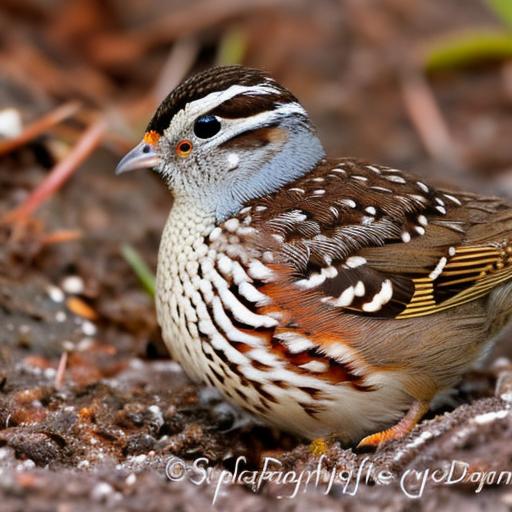Raising baby quail can be a rewarding experience, but it’s important to understand their specific needs in order to ensure their health and well-being. Baby quail, also known as chicks, require a warm and cozy environment, proper bedding, and access to food and water in order to thrive. They are delicate creatures that need careful attention and care in their early stages of life. Understanding their needs is crucial to successfully raising healthy and happy quail.
Baby quail have specific temperature requirements, as they are unable to regulate their body temperature effectively in the first few weeks of life. They need a warm and cozy brooder to mimic the conditions provided by a mother hen. Additionally, they require the right bedding to provide comfort and support for their delicate bodies. It’s also important to provide the right heat sources and monitor the temperature regularly to ensure that it remains within the appropriate range for the baby quail. Proper ventilation is also essential to maintain good air quality and prevent respiratory issues. By understanding and meeting these needs, you can create a nurturing environment for your baby quail to thrive and grow into healthy adult birds.
Key Takeaways
- Baby quail need a warm and cozy environment to thrive
- Use a brooder with a heat source to maintain the right temperature
- Provide the right bedding such as paper towels or pine shavings
- Monitor temperature closely and adjust heat sources as needed
- Ensure proper ventilation to prevent moisture buildup and maintain air quality
- Keep an eye on the baby quail’s behavior for signs of distress or discomfort
Creating a warm and cozy brooder
Creating a warm and cozy brooder is essential for the health and well-being of baby quail. A brooder is a heated enclosure that provides a safe and warm environment for young chicks. It mimics the conditions provided by a mother hen, ensuring that the baby quail stay warm and comfortable. There are various types of brooders available, including heat lamps, heating pads, and radiant heaters. It’s important to choose the right type of brooder for your specific needs and to ensure that it provides consistent and even heat distribution.
In addition to providing the right heat source, it’s important to line the bottom of the brooder with appropriate bedding to provide comfort and support for the baby quail. Pine shavings or straw are commonly used as bedding materials, as they provide good insulation and absorb moisture effectively. It’s important to keep the bedding clean and dry to prevent the development of bacteria and mold, which can be harmful to the baby quail. By creating a warm and cozy brooder with the right heat source and bedding, you can provide a nurturing environment for your baby quail to thrive and grow.
Providing the right bedding
Providing the right bedding is crucial for the health and well-being of baby quail. The bedding material should provide comfort and support for the delicate bodies of the chicks, as well as good insulation and moisture absorption. Pine shavings and straw are commonly used as bedding materials for baby quail, as they meet these requirements effectively. It’s important to line the bottom of the brooder with a thick layer of bedding to provide a soft and comfortable surface for the chicks to rest on.
In addition to providing comfort, the right bedding also plays a role in maintaining good hygiene in the brooder. It absorbs moisture effectively, helping to keep the brooder clean and dry. This is important for preventing the development of bacteria and mold, which can be harmful to the baby quail. It’s important to regularly clean and replace the bedding to ensure that it remains clean and dry at all times. By providing the right bedding, you can create a comfortable and hygienic environment for your baby quail to thrive and grow.
Using heat sources
Using the right heat source is essential for creating a warm and cozy environment for baby quail. In their early stages of life, baby quail are unable to regulate their body temperature effectively, so they rely on external sources of heat to stay warm. There are various types of heat sources available, including heat lamps, heating pads, and radiant heaters. It’s important to choose the right type of heat source for your specific needs and to ensure that it provides consistent and even heat distribution.
Heat lamps are a popular choice for providing warmth to baby quail, as they can be easily adjusted to maintain the appropriate temperature in the brooder. Heating pads are another option, providing a gentle and consistent source of heat for the chicks. Radiant heaters are also effective at providing even heat distribution throughout the brooder. Whichever type of heat source you choose, it’s important to monitor the temperature regularly and adjust the heat source as needed to ensure that it remains within the appropriate range for the baby quail. By using the right heat source, you can create a nurturing environment for your baby quail to thrive and grow.
Monitoring temperature and adjusting as needed
Monitoring the temperature in the brooder is crucial for the health and well-being of baby quail. It’s important to maintain a consistent temperature within the appropriate range for the chicks, as they are unable to regulate their body temperature effectively in their early stages of life. The ideal temperature for baby quail is around 95-100 degrees Fahrenheit in the first week, with a gradual decrease of 5 degrees per week until they are fully feathered at around 6 weeks old.
It’s important to use a reliable thermometer to monitor the temperature in the brooder regularly, especially during the first few weeks of life when the chicks are most vulnerable. If the temperature is too low, the baby quail may become chilled, leading to health issues or even death. If the temperature is too high, they may become overheated, leading to dehydration or heat stress. It’s important to adjust the heat source as needed to maintain a consistent temperature within the appropriate range for the baby quail. By monitoring the temperature regularly and making adjustments as needed, you can create a nurturing environment for your baby quail to thrive and grow.
Ensuring proper ventilation

Proper ventilation is essential for maintaining good air quality in the brooder and preventing respiratory issues in baby quail. Adequate airflow helps to remove excess moisture, ammonia, and other airborne contaminants from the brooder, creating a healthy environment for the chicks to thrive in. It’s important to ensure that there is enough ventilation in the brooder without creating drafts that could chill the baby quail.
One way to ensure proper ventilation is by using a brooder with adjustable vents or by placing a small fan near the brooder to promote air circulation. It’s important to monitor the air quality regularly and make adjustments as needed to ensure that it remains clean and fresh for the baby quail. By ensuring proper ventilation, you can create a healthy environment for your baby quail to thrive and grow.
Keeping an eye on the baby quail’s behavior
Keeping an eye on the behavior of baby quail is crucial for identifying any potential issues or health concerns early on. Healthy baby quail should be active, alert, and curious about their surroundings. They should be eating and drinking regularly, with bright eyes and clean feathers. It’s important to monitor their behavior regularly and look out for any signs of distress or illness.
Common signs of distress or illness in baby quail include lethargy, huddling together for warmth, labored breathing, or unusual vocalizations. If you notice any of these signs, it’s important to investigate further and take appropriate action to address any potential issues. It’s also important to handle the baby quail gently and minimize stress as much as possible, as stress can weaken their immune system and make them more susceptible to illness.
By keeping an eye on the behavior of your baby quail and responding promptly to any signs of distress or illness, you can ensure their health and well-being as they grow into healthy adult birds.
If you’re looking for tips on how to keep baby quail warm, you might also be interested in learning about the importance of insulating a chicken coop. Insulation can help maintain a comfortable temperature for your poultry, including baby quail. Check out this insightful article on how to insulate a chicken coop to ensure your feathered friends stay cozy and warm during colder months.
FAQs
What temperature should baby quail be kept at?
Baby quail should be kept at a temperature of around 95-100 degrees Fahrenheit for the first week of their lives, and then gradually decreased by 5 degrees each week until they are fully feathered.
What are some ways to keep baby quail warm?
Some ways to keep baby quail warm include using a heat lamp, heat plate, or brooder to provide a consistent source of warmth. It’s important to monitor the temperature regularly to ensure it stays within the appropriate range.
How can I tell if baby quail are too cold?
If baby quail are too cold, they may huddle together, chirp loudly, or appear lethargic. It’s important to monitor their behavior and adjust the heat source accordingly to keep them comfortable.
Are there any specific bedding materials that can help keep baby quail warm?
Bedding materials such as pine shavings or straw can help provide insulation and keep baby quail warm. It’s important to keep the bedding clean and dry to prevent any issues with moisture or mold.
Can baby quail be kept warm without a heat source?
It is not recommended to keep baby quail warm without a heat source, as they are very susceptible to temperature changes and require a consistent source of warmth for their well-being.
Meet Walter, the feathered-friend fanatic of Florida! Nestled in the sunshine state, Walter struts through life with his feathered companions, clucking his way to happiness. With a coop that’s fancier than a five-star hotel, he’s the Don Juan of the chicken world. When he’s not teaching his hens to do the cha-cha, you’ll find him in a heated debate with his prized rooster, Sir Clucks-a-Lot. Walter’s poultry passion is no yolk; he’s the sunny-side-up guy you never knew you needed in your flock of friends!







